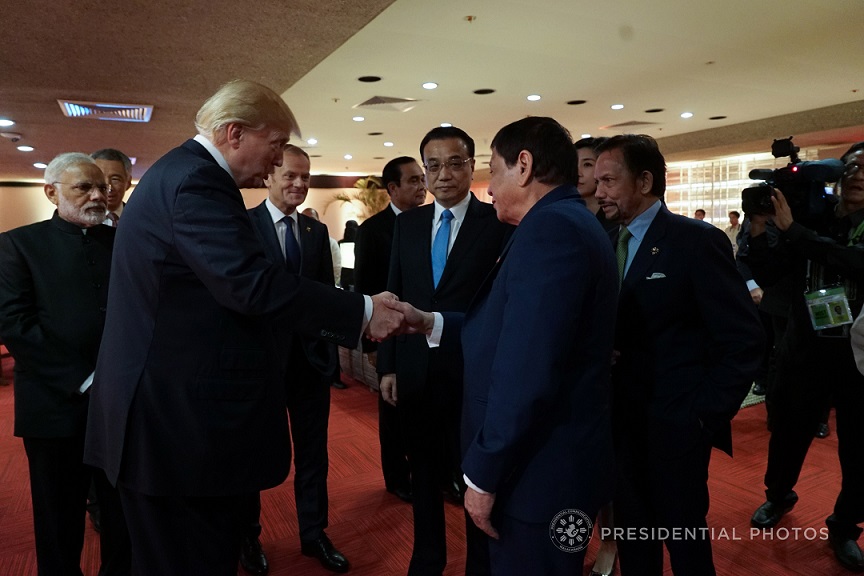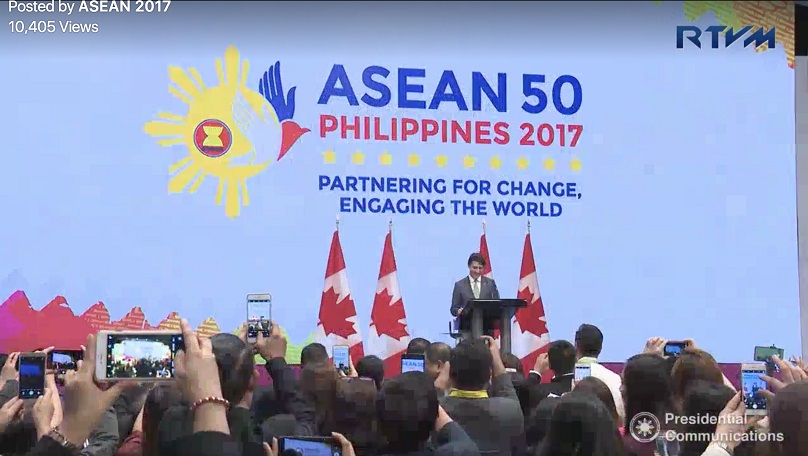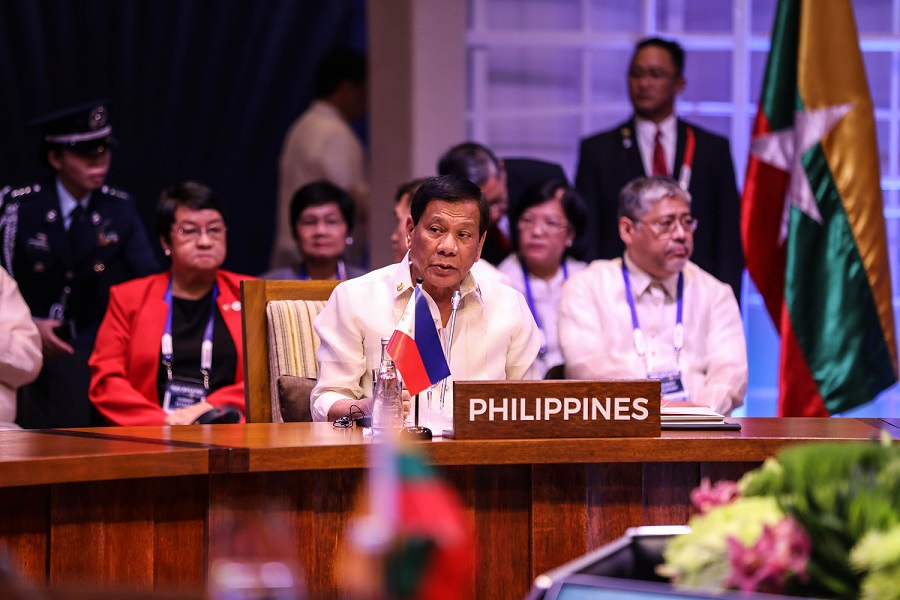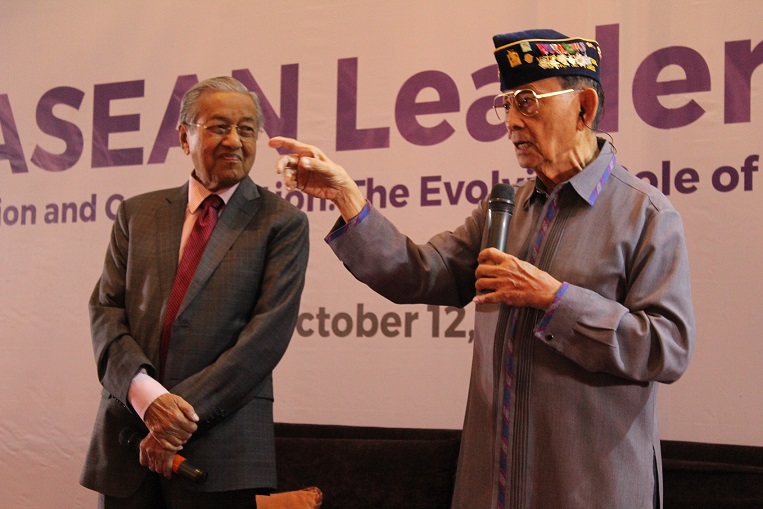The occasion has always been fun especially if one is fond of pantomime like the kabuki drama of Japan or Wayang shadow play of Indonesia. The actors in kabuki wear masks that keep the audience guessing who they are and what their plans are; in Wayang they act behind a transparent curtain as they try to convey their message using only action with gestures.
The 31st ASEAN summit and Related Summits has such drama.

Pres. Duterte greets Leaders led by U.S. Pres. Donald Trump, China’s Premier Li Keqiang, Indian Prime Minister Narendra Modi, and Sultan of Brunei Hassanal Bolkiahbefore the start of the 12th East Asia Summit at the PICC. Malacañang photo by King Rodriguez.
Summitry is the highest form of multilateral diplomacy. The true value of summits is measured not so much in formal meetings, formal statements and outcome documents but on bilateral meetings between breaks which normally accompany the summit on “side forums” especially among non-government institutions and press statements and “body language” of the leaders.
Let us assess the Philippine hosting of the 31st ASEAN Summits in this context with the Philippines as host:
The immediate claim to success of this event is the way the proceeding went as planned especially on security. The Philippines was also able to showcase our culture through food, music, dances, songs and our ever “scratchy” barongs. There is also consensus that the Philippines hosted the summit successfully.
The Consensus on the Protection and Promotion of the Rights of Migrant Workers is hyped as a landmark document and highlighted as a signal achievement of the Philippine chairmanship of the 31st ASEAN summit. The use of the words “Consensus” instead of say “Agreement” intrigues and evokes thoughts that consent to the document varies among members. Of course, there is already the U.N. Convention on the Rights of Migrant Workers and their Families. Also the implementation of the Consensus will be subject to the respective laws of the ASEAN member countries. The success of the Consensus will again depend on the good faith and political will of ASEAN.
In the early weeks of the Philippine chairmanship of the golden anniversary of ASEAN, the vision was to have a Code of Conduct on the South China Sea by the end of the year. As it turned out, it was an overly ambitious and unrealistic objective. An Agreed Framework came out of the talks between ASEAN and China in August. Details were withheld from the public; what was leaked was some sort of table of contents for a novel.
A legally binding pact in the SCS is a bridge too far, a mirage at this time. We should learn our lesson on the issue. In 1999, the Philippines as chair presented a draft Code, which China rejected. ASEAN, led by the Philippines kept the issue alive and in 2002 succeeded in concluding the DOC- Declaration on the Code of Conduct in the South China Sea. The last paragraph commits the parties to work for a Code.
ASEAN efforts to draft the Code was not with China’s assertion “when the time is ripe.” If the time is now ripe, it could mean that China has finished its projects and objectives in the SCS; or a realization that the Code will take time to negotiate and thus buy time to finish its plans in the area.
The agreement to negotiate a Code of Conduct is a Trojan horse which the ASEAN, especially the Philippines should be wary of. It must craft the draft similar to what we did in the DOC and be unified and dominate the negotiations.
A COC which mentions only non-militarization in the SCS is a step back from the DOC which proscribes occupation of features and urges restraint in the conduct of activities in the area. A COC that will not even refer to the Arbitral Ruling will be another loss for the Philippines. By our silence and our statements, the victory we won last year will be consigned to the dustbin of history.
China has studied and researched well the dynamics not only of ASEAN members but of its dialogue partners – their needs, their weaknesses and strengths, the realities on the ground and at sea.
In the case of the Philippines, China does not even have to read us – we announce our thoughts and feelings too often to the extent that we are unconsciously advocating their position.
In the past, China had always yielded to ASEAN the central role in plans and projects in the South China Sea and has been vocal about it. Today, it is mute on this strategy and is leading some ASEAN members by their noses.
In the past, China has always assured that they have no ambition for hegemony as a world power. Today, their vision and mission are not only for China but for the world. As Xi Jinping said, China is ready to assume global leadership if no other power will.
Look at the economic pillar of ASEAN to see more tangible achievements of the 31st ASEAN Summit and Related Summits. Welcome the launch of AMEN (ASEAN Mentorship for Entrepreneurs Network) and digest the nuggets of wisdom of ABIS (ASEAN Business and Investment Summit). It is now comforting to read the joint statements for the bilateral summits between ASEAN and its dialogue partners than reading the Chairman’s statement.
We are partnering for change and engaging the world and will continue to do so forward the next 50 years. But now is the time to begin taking off the masks from the Kabuki plays and the shadow drama of Mayang which we have been doing the last 50 years. Then ASEAN summits and Related Summits can have more relevance and meaning for people on the ground. They are really the raison d’être of the Association.
(The author is a veteran Philippine diplomat. He was the Philippine Permanent Representative to the United Nations from May 2003 to February 2007. Prior to that, he was Foreign Affairs Undersecretary for Policy.




